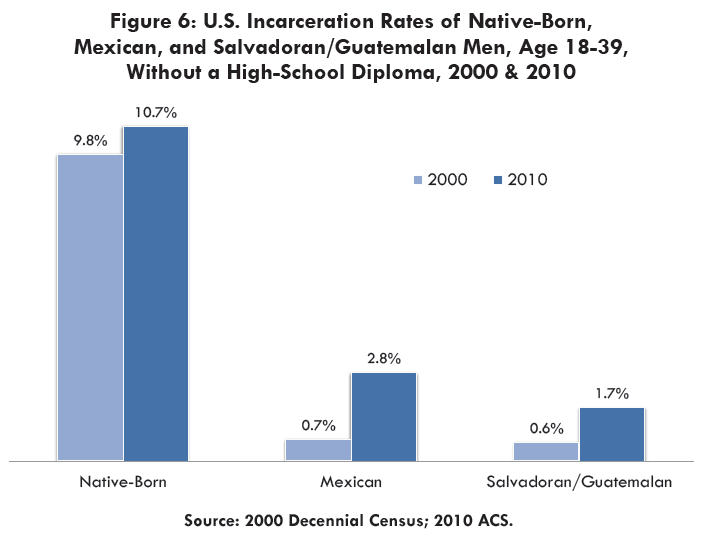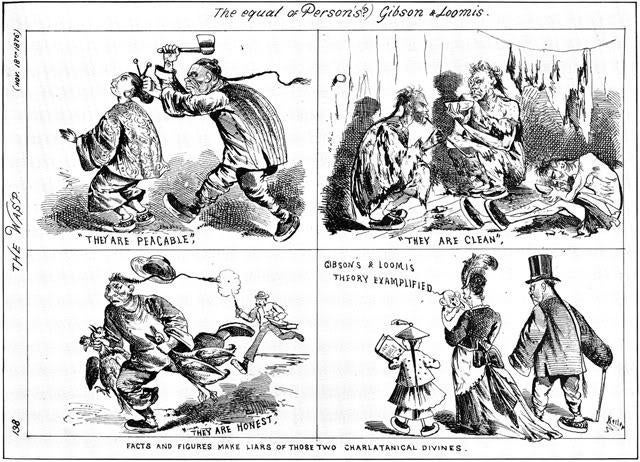
How the far right misuses rhetoric and data to convince the public undocumented immigrants are violent criminals
The most notorious statement to drip from Donald Trump’s lips this political season was a broad and bombastic smear: He described undocumented immigrants entering the United States from Mexico as violent criminals.
Those words should be awfully familiar by now:
When Mexico sends its people, they’re not sending their best. ... They’re sending people that have lots of problems, and they’re bringing those problems with us. They’re bringing drugs. They’re bringing crime. They’re rapists. And some, I assume, are good people.
These slurs aren’t true, but critics of undocumented immigrants often spout them as if they were. The facts, however, reveal something different: Crime rates are lower among immigrants — undocumented or otherwise — and their communities are often among the safer spaces to live in the United States.
The Propaganda Device
We’ll get to the data which proves that, but first let’s take a closer look at what the right is doing here. Because it’s not just Trump who’s pushing this myth. During their National Convention, the Republicans took pains to present three understandably grieving parents to graphically make the case that undocumented immigrants are violent criminals.
These families have suffered in ways that no one should have to and no one should deny their personal pain and anguish. However, the Republicans selected their stories to create a narrative and to reinforce a fallacy. And they did this in a way which allows them some semblance of plausible deniability. They can say, “We never said immigrants are all violent criminals” — even if Trump has already said as much. Instead, they string these incidents of violence together with the clear intention of letting people draw their own conclusions.
Consider that the Bush administration used this same rhetorical tactic to convince some 70 percent of the U.S. public that Iraq attacked us on 9/11. They used the words “Iraq” and “9/11” in the same breath repeatedly without ever actually saying Iraq attacked us on 9/11. That gave them plausible deniability if anyone ever accused them of saying Iraq attacked us. In an interview with Meet the Press, Dick Cheney even admitted, “I think it’s not surprising that people make that connection.” Certainly not surprising, since the administration had strung Iraq together with 9/11 rhetorically for months by that point.
So the Trump crowd uses this trick — this propaganda device — to convince people that undocumented immigrants are equivalent to violent criminals. Obviously, Trump isn’t terribly sophisticated about it: His language is blunt and vulgar. What the Republicans did at their Convention displayed a modicum more sophistication. They let the speakers do the work for them. They offered no statistics or data or context whatsoever for the stories the speakers told. Nonetheless, they provided enough fodder to convince the credulous that a high number of undocumented immigrants must be violent criminals.
What the Data Actually Says
If you’re looking for real data to show that undocumented immigrants commit violent crimes at a higher rate than native-born Americans, you’ll be hard pressed to find it. What you can find, however, is data showing that immigrants are less likely to commit violent crimes or to be found in jail. In a July 2015 report, the American Immigration Council shows that “holds true for both legal immigrants and the unauthorized, regardless of their country of origin or level of education.”
For example, the Council shows that from 1990 to 2013, the number of undocumented immigrants did triple from 3.5 million to 11.2 million. However, the violent crime rate also fell 48 percent during that time. And the property crime rate fell 41 percent, too. So crime rates have gone down as the immigration rate has gone up.
Furthermore, via a 2010 survey, the report’s authors found that about 1.6 percent of immigrant males from the ages of 18–39 were incarcerated. Compare that against 3.3 of the native-born population.
You’ll note that those statistics refer to immigrants in general, not undocumented immigrants, specifically. So some critics will claim that if you could tease out the undocumented immigrants from that population, you’d find a higher violent crime rate among them. The problem is there’s no evidence to support that.
Consider also that separating the authorized immigrants from the unauthorized is difficult. The U.S. Census is the best source of data on immigrants to the United States. However, as Walter Ewing, the report’s senior author explained to me, “The census does not differentiate according to legal status, so there is no way you can directly tease out undocumented immigrants using census data.”
Instead, we’re left with a couple of indirect ways to draw conclusions about undocumented immigrants and any proclivities they may have towards violent crimes.

First, Ewing explained, one of his colleagues looked at census data for Mexican, Salvadoran, and Guatemalan men, aged 18 to 39, without a high-school diploma. Given those parameters, he said, “you can be pretty sure that the majority of those people are undocumented.” Among these immigrants, there was a 2.8 percent incarceration rate among Mexican men. Compare that with a rate of 10.7 percent among similarly educated native-born men. That rate was as low as 1.7 percent among the Salvadoran and Guatemalan men.
The other option, Ewing says is to look at cities that have large influxes of undocumented immigrants — “gateway” cities — and how their crime rates have trended over the previous 10 years. This includes cities like Miami, Chicago, El Paso, San Antonio, San Diego and Austin. Again, in these cities, the crime rates are falling.

In many ways, this is all old news. Ewing and his colleagues point out that studies over the past 100 years typically reach the same conclusion: That you’ll find lower crimes rates among immigrants than native-born Americans. They point to studies in three different decades, which attempted to show that criminality increased among the immigrant populations. Instead, they each concluded the opposite.
Some suggest that crime in the undocumented immigrant community is underreported because those individuals are afraid of reporting crime because they may be detected and deported. However, one cannot avoid considering another intuitive and logical dynamic: These same undocumented immigrants are more likely to operate within the law in order to avoid detection and deportation, creating safer communities as a result. That’s the conclusion Ewing and his co-authors reached, but they determined “the terminological sleight-of-hand inherent in the government’s definition of ‘criminal alien’ perpetuates and exacerbates the fallacy of a link between immigration and crime.”
Misuse & Distortion of Data
Consider this, too. Even if data could be presented to show higher crime rates among undocumented immigrant communities in some areas, that would not mean that the overall crime rate is higher for undocumented immigrant communities. If this sounds glaringly obvious, it’s nonetheless an argument that’s repeated constantly in the media, by politicians, and, of course, in the comments section of any given web site. It’s much like someone arguing there is no global warming because they had a cold winter in their town: Data from a single area might differ from a national average, but that does not mean the overall statistics are invalid.
So data is easy to misuse. Sadly, it’s also easy to fabricate.
Take, for example, Tom Tancredo’s claim in an August 2015 Breitbart article that “illegal aliens” accounted for 30 percent of murders in many states. He offered more detailed statistics including the following:
- “Between 2008 and 2014, 40 percent of all murder convictions in Florida were criminal aliens. In New York it was 34 percent and Arizona 17.8 percent.
- “During those years, criminal aliens accounted for 38 percent of all murder convictions in the five states of California, Texas, Arizona, Florida and New York, while illegal aliens constitute only 5.6 percent of the total population in those states.”
Problem is these statistics are dead wrong. So wrong that Politifact wrote a detailed rebuttal of Tancredo’s piece and demonstrated that his figures were greatly inflated — sometimes fives times larger than any verifiable figures. They gave him a flat “false” rating on their Truth-O-Meter. However, the Breitbart piece stands today without correction despite the Politifact takedown. The researcher Tancredo quoted even reached out to Breitbart to complain his work had been referenced improperly. A year later, there’s still no indication of any of these inaccuracies or their rebuttals appending the piece. Consequently, it continues to be shared on social media among the far right as evidence of horrific murder rates by undocumented immigrants. Although it’s complete fiction.
Of course, Breitbart doesn’t care to correct Tancredo’s shoddy diatribe because it reinforces a narrative about undocumented immigrants the website embraces. And it reinforces what many people want to believe.
“You can find many examples of any particular group of people committing horrible crimes: white men, white women, black men, black women, I mean, everyone. You can find the anecdotes, but that has nothing to do with crime rates.” — Walter Ewing, American Immigration Council
Similarly, many critics are fond of reaching for anecdotal evidence to paint undocumented immigrants as violent criminals. Walter Ewing agrees that these anecdotal stories do not undermine overall statistics, either: “You can find many examples of any particular group of people committing horrible crimes: white men, white women, black men, black women, I mean, everyone. You can find the anecdotes, but that has nothing to do with crime rates.”
On those stories shared by grieving parents at the Republican National Convention, he noted, “You could have just as easily gotten someone up there to talk about Sandy Hook and the dangers posed by white men with automatic weapons.”
Undocumented Immigrants in Federal Prison
Did you know there is a high number of undocumented immigrants in our federal prisons? Breitbart offers a figure of almost 37 percent, while Trump says there are “hundreds of thousands” of undocumented immigrants in our state and federal prisons. Trump’s figure (unsurprisingly) is flat-out wrong. In fact, undocumented immigrants make up four or five percent of our nation’s entire inmate population. While closer to the truth, the statistic Breitbart presents deserves further examination.
First, the overall federal prison population is relatively small compared to the overall prison population — about 10 percent of it in 2013. “So you get a very distorted picture of the immigrant population if you only look at federal prisons,” Walter Ewing told me.
Second, the overwhelming majority of these undocumented immigrants (76 percent in 2013, for example) are in federal prison for immigration violations. “You get people in there for immigration violations. That does not make them violent criminals,” says Ewing on this topic. “It just means because they’re immigrants, they’re in the federal system.” Yet the far right uses the statistic to infer that those individuals are in federal prisons due to horrific violent crimes such as drug trafficking, human trafficking, murder and kidnapping.
It’s important to examine the circumstances that created this situation, too. As this Pew report explains, the growing presence of undocumented immigrants in federal prisons can be attributed to the tougher enforcement of unlawful reentry convictions. In other words, immigrants were increasingly being administered federal charges because “they have entered or attempted to enter the U.S. illegally more than once.” For example, “Between 1998 and 2010 alone, growth in the number of immigration offenders accounted for 56 percent of the increase in federal prison admissions.” And in 2005, the U.S. Border Patrol began to significantly reduce the number of voluntary returns they allowed upon seizing immigrants, sending them to prison instead. Additionally, they streamlined the process for prosecution under a “zero-tolerance” program called, well, Operation Streamline. In other words, the undocumented immigrant population is growing in federal prisons because we’ve gotten much, much tougher on undocumented immigration.
This raises two important points: First, though the harshest critics of undocumented immigrants enjoy highlighting these federal prison statistics, they typically downplay the actual reason they are imprisoned. Secondly, you could argue the data shows the system is working as more individuals are being captured and their offenses are being treated more severely. (Some might argue, too severely.) So those who offer this data point should also acknowledge that more undocumented immigrants are being prosecuted than ever before. You’re not likely to see Donald Trump or Breitbart or others of their ilk highlight that fact, though.
Given these arguments, of course, some critics will respond that even one violent crime, one death at the hands of an undocumented immigrant is too many. After all, such a tragedy wouldn’t have happened if the undocumented immigrant weren’t here. But this emotion-laden argument still thrives on ignoring the data showing undocumented immigrants aren’t committing acts of violence at rates equal to native citizens. It’s a convenient argument because it sounds logical, but it ignores that violent crimes exist regardless of who is committing them. It typically hopes to act in service of the idea that we should deport some 11 million undocumented immigrants from the country, despite their overall decidedly peaceful status.
The same argument is used to prevent refugees from entering the country. We’re told if there’s a terrorist attack originating from “radical Islamic” quarters, then we must keep all people from Muslim countries out of our own country, despite the fact that the numbers of people committing such crimes are astronomically small.
Obviously, many folks making these arguments don’t care about such trifles as statistics or data. Still, it’s important for us all to understand the true nature and scale of the issue, so we can at least argue for accuracy and integrity in the public debate. Furthermore, there is a sizable group of people out there open to adjusting their understanding of the issue when presented with the facts. They’re just not getting to see them. Instead, they’re getting doses of rhetorical trickery and distorted data — whether it’s Donald Trump’s ham-fisted arguments and thuggish name-calling or the Republican’s moderately more refined stream of propaganda.
There may be good reasons to remove many undocumented immigrants from the country. (Though removing them all would be both impossible and inhumane. And we already deport about 400,000 people per year.) There may be good reasons to entertain ways of discouraging them from entering the country in the first place. (Though the numbers of undocumented immigrants entering the country are in decline.) There may be many good reasons to overhaul our immigration system. Let’s look at them. But let’s not take a group of already deeply disadvantaged immigrants and paint them as a horde of violent criminals. It’s not true. And it’s not right.
Further Reading
- The Criminalization of Immigration in the United States, American Immigration Council, 13 July, 2015
- Donald Trump’s False Comments Connecting Mexican Immigrants and Crime, The Washington Post, 8 July 2015
- The Rise of Federal Immigration Crimes, Pew Hispanic, 18 March, 2014
This piece also appears on Medium.com.
Follow Robert Stribley on Twitter
This is the second in a series of articles about undocumented immigration in the United States. The first discusses the myth that there is an immigration “crisis” in the U.S. and explains how undocumented immigration is in decline.

